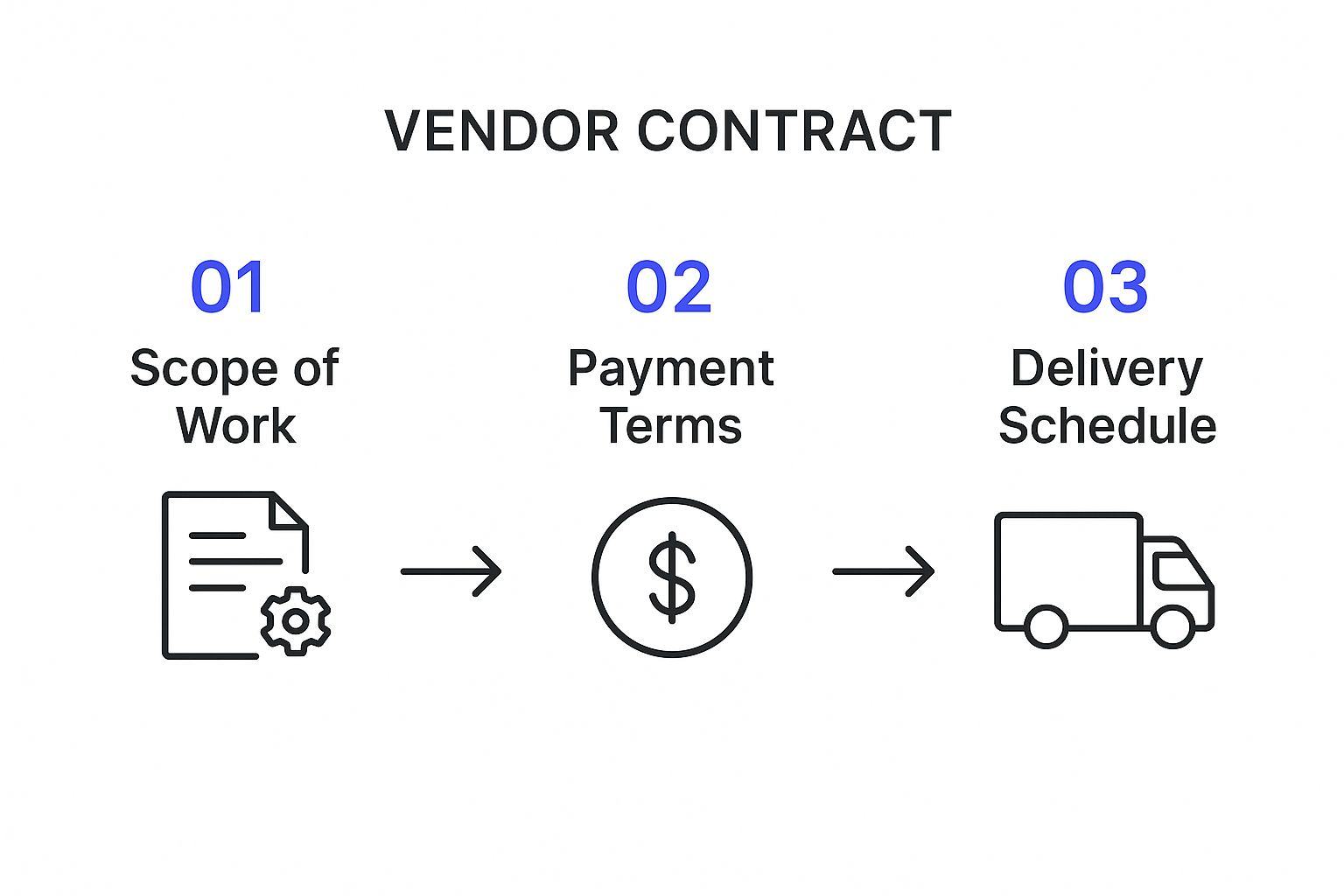
Vendor contract management is the strategic process of creating, executing, and analyzing agreements with third-party suppliers of goods and services. It's not just filing paperwork; it's a proactive system for managing costs, minimizing risks, and ensuring vendors deliver on their promises.
Why Vendor Contract Management Is Your Hidden Superpower

Ever tried to build a house without blueprints? You might get the walls up, but the structure would be weak, the dimensions would be off, and the final cost would be a complete guess. Running a business without solid vendor contract management is exactly like that. It’s the foundational framework that defines every relationship with the partners providing your critical goods and services.
This process is so much more than just an administrative chore. It's a core business function that directly impacts your financial health, operational stability, and legal standing. When handled poorly, it becomes a silent drain on your resources. But when managed well, it transforms into a powerful tool for driving real savings and efficiency.
The Real-World Financial Stakes
The numbers paint a stark picture. Studies show that poor contract handling can gut a company's bottom line. On average, businesses lose an astonishing 9.2% of their annual revenue due to simple contract mismanagement. For larger companies, that leakage can swell to 15%. These losses often sneak in through missed deadlines, auto-renewals on unfavorable terms, and non-compliance penalties that fly completely under the radar. You can dive into the complete findings on how contract management impacts revenue on procurementtactics.com.
On the flip side, a robust vendor contract management strategy isn't just about plugging leaks; it’s about creating value. By taking control of the process, your organization can:
- Slash Costs: Proactively managing renewals and obligations stops overspending in its tracks and helps you capture savings opportunities.
- Mitigate Risk: Clear terms and consistent compliance tracking shield you from costly legal disputes and regulatory fines.
- Boost Performance: Holding vendors accountable to their Service Level Agreements (SLAs) ensures you get the quality you actually paid for.
"Effective vendor contract management isn't an expense; it's an investment in financial stability and operational excellence. It turns a static legal document into a dynamic asset that actively protects and builds business value."
This strategic mindset shifts your focus from reactive firefighting to proactive value creation. It ensures that every dollar spent with a vendor is maximized and every potential risk is flagged before it can become a full-blown crisis.
More Than Just Paperwork
Thinking of vendor contract management as just a high-tech filing cabinet is a common and costly mistake. It’s an active, ongoing cycle that involves multiple departments—from procurement and finance to legal and operations. It’s about building a single source of truth where all stakeholder agreements are stored, tracked, and analyzed.
The table below breaks down the tangible differences between a disorganized approach and a strategic one, highlighting the significant financial implications.
The Financial Impact of Vendor Contract Management
When you compare a disorganized approach to a strategic one, the financial and operational differences are night and day. One path leads to lost revenue and inefficiency, while the other drives savings and growth.
| Metric | Poor Management Outcome | Effective Management Outcome |
|---|---|---|
| Revenue Leakage | High risk of losing up to 15% of annual revenue | Minimized leakage, with potential cost savings of up to 2% of annual expenses |
| Operational Efficiency | Manual, error-prone processes that create bottlenecks and delays | Automated workflows that accelerate deal closures and reduce manual errors |
| Risk Exposure | High vulnerability to missed renewal dates, compliance failures, and legal disputes | Reduced exposure through automated alerts, clear accountability, and audit trails |
| Vendor Performance | Inconsistent service delivery and lack of accountability for SLAs | Improved vendor performance through clear expectations and systematic tracking |
Ultimately, the goal is to move from a reactive, paper-shuffling mindset to a proactive strategy that turns your contracts into assets that work for you. Effective management isn't just about avoiding problems; it's about seizing opportunities.
Navigating the Vendor Contract Lifecycle
Every vendor contract has a life of its own, a journey that starts long before anyone signs on the dotted line and continues well after the work is done. Think of it less as a one-off task and more as a continuous cycle. Understanding each stage of this journey—the vendor contract lifecycle—is the key to managing risk and getting the most value out of your vendor relationships.
When you can see the whole map, you can pinpoint the exact moments where a smart move can save you time, money, and a whole lot of headaches down the road.
Stage 1: Contract Creation and Authoring
This is where it all begins. The creation stage is about building the blueprint for your entire vendor relationship. It’s far more than just grabbing a template and filling in the blanks; it's about translating your business needs into clear, legally sound terms. Rushing this step is a recipe for disaster, often leading to vague language that causes problems later.
A common pitfall is relying on generic or outdated templates that don't fit the specific deal you're making. The best approach is to create a library of standardized, pre-approved clauses for things like payment schedules, confidentiality, and liability. This makes the process faster and ensures every contract starts from a strong, consistent foundation.
As you can see, the core of any good contract rests on three pillars: defining the scope, setting payment terms, and establishing delivery schedules.

Getting these three elements right from the start creates a clear and logical backbone for the entire agreement.
Stage 2: Negotiation and Approval
With a draft in hand, it's time to negotiate. This is the crucial back-and-forth where you and your vendor work to agree on the terms. The goal here isn't to "win" but to land on an agreement that's fair, clear, and realistic for everyone involved.
During this phase, keeping track of changes is everything. Without solid version control, critical edits can easily get lost in a sea of emails and redlines, leading to major confusion. Using tools that track every change ensures everyone is always working off the same page. If you want to dive deeper into this, we have a complete guide on the complete contract lifecycle management journey that covers it all.
Don't forget the internal approvals. A single contract might need a thumbs-up from Legal, Finance, and Operations. Old-school methods like passing paper from desk to desk or getting buried in email chains are slow, inefficient, and just asking for trouble.
A solid negotiation and approval process is about more than just getting a signature. It builds consensus and makes sure every stakeholder is on board before the contract becomes legally binding.
Stage 3: Execution and Obligation Management
Execution is the moment of truth—when the contract is formally signed and becomes a legally binding document. Today, this is often handled with e-signatures, which dramatically cuts down on the time it takes to finalize everything. Once signed, the contract shifts from being a plan to being an active commitment.
This is where the real work of vendor contract management begins: obligation management. It's the ongoing job of making sure both you and your vendor are holding up your ends of the bargain. This includes:
- Key Dates: Keeping an eye on deadlines for payments, deliverables, and reports.
- Milestones: Tracking progress to make sure the project stays on schedule.
- Compliance: Ensuring all regulatory and internal policies are being followed.
Letting these obligations slip is where companies lose a ton of money. In fact, a report from World Commerce & Contracting found that poor contract management can cost businesses up to 9% of their annual revenue, mostly from missed deadlines and unfulfilled commitments.
Stage 4: Renewal or Termination
As a contract approaches its end date, you have a choice to make: renew, renegotiate, or terminate. This decision shouldn't be a last-minute scramble. It should be based on a careful review of the vendor’s performance. Did they meet their goals? Did you get the value you expected?
Automated alerts are your best friend here. Without them, it's dangerously easy to let contracts auto-renew on unfavorable terms just because the expiration date snuck up on you. Being proactive gives you plenty of time to assess performance and negotiate a better deal if you decide to continue the relationship.
And if you choose to terminate, make sure you follow the process laid out in the contract to avoid any legal blowback. This final step then loops right back to the beginning, as the lessons you learn from one contract lifecycle will make the next one even stronger.
Putting Effective Contract Management Into Practice

Knowing the theory behind the vendor contract lifecycle is one thing, but actually putting it into practice is a whole different ballgame. Moving from a reactive, "fire-fighting" mode to proactive management means building a set of solid habits. Think of these practices as the building blocks for a system that not only protects your business but also uncovers hidden value in your vendor relationships.
The first step is simply getting organized. Without a strong foundation, even the best strategies will eventually fall apart under the weight of messy files and fuzzy responsibilities. The goal here is to create a system that works today and can grow with you tomorrow.
Create a Centralized Contract Repository
The single most powerful change you can make is to create a single source of truth for every contract you have. It’s a game-changer. Imagine trying to find a book in a library where volumes are scattered across different rooms, piled on the floor, and shoved into unmarked boxes. That’s what managing contracts feels like without a central hub.
This repository should be a secure, searchable, and easy-to-access digital home where every signed agreement lives. Right away, you eliminate the chaos of digging through old emails, confusing shared drives, and dusty filing cabinets. When everything is in one place, you gain instant visibility into your entire contract portfolio, which is the first step toward getting things under control.
A centralized repository turns static, forgotten documents into active, manageable assets. It’s the foundational shift from just storing contracts to strategically managing them.
Standardize with Templates and Clause Libraries
Consistency is your best friend when it comes to fighting off ambiguity and human error. When you create contracts from scratch for every new vendor, you open the door to unnecessary risks and inefficiencies. Instead, using standardized, pre-approved templates ensures every new agreement starts from a strong, compliant foundation.
This doesn't mean forcing a one-size-fits-all approach. It's about building a pre-approved clause library—a collection of standard legal language for common sections you use all the time, such as:
- Confidentiality Agreements: Make sure your sensitive information is always protected with the same bulletproof wording.
- Payment Terms: Use uniform language to define how and when you pay, which cuts down on billing confusion.
- Liability Clauses: Set clear, pre-vetted limits on risk exposure across all your agreements.
Using a clause library speeds up the drafting process dramatically and takes a huge load off your legal team. This frees them up to focus on high-stakes negotiations instead of getting bogged down in routine paperwork. For a deeper dive, you can explore more detailed contract management best practices that top organizations rely on.
Assign Clear Roles and Responsibilities
A contract without a clear owner is like an orphan—no one is looking out for its success. To manage vendor contracts well, you need to assign specific roles and responsibilities to individuals or teams. Who is supposed to track key dates? Who is in charge of performance reviews? Who has the final say on renewals?
Defining these roles gets rid of confusion and stops critical tasks from slipping through the cracks. A simple responsibility chart can make a world of difference:
| Task | Responsible Role | Key Actions |
|---|---|---|
| Performance Tracking | Contract Manager | Monitors vendor adherence to SLAs and KPIs. |
| Renewal/Termination | Department Head | Assesses performance data to make strategic decisions. |
| Compliance Audits | Legal/Compliance Officer | Conducts periodic reviews to ensure adherence to regulations. |
This kind of clarity ensures someone always has their eyes on each stage of a contract's life.
Automate Alerts for Key Dates
Missing a critical date is one of the most common—and costly—mistakes in vendor contract management. An unwanted auto-renewal on an expensive, underperforming service can drain thousands from your budget. On the flip side, missing your chance to terminate a bad contract can lock you into another year of headaches.
Tracking these dates manually with spreadsheets or calendar reminders is better than nothing, but it's dangerously prone to human error. Automated alerts are the safety net your business needs. Modern contract tools can automatically scan documents, pull out key dates—like expirations, renewals, and report deadlines—and send notifications to the right people with plenty of time to act. This simple shift moves your team from being reactive to proactive, giving you the breathing room to make smart, informed decisions.
Solving Common Contract Management Challenges
Even with the best intentions, vendor contract management can feel like you're navigating a minefield. Roadblocks are just part of the game, but even a small oversight can have big consequences. From files that vanish into thin air to surprise audits, these challenges gum up workflows, expose your business to risk, and create frustrating bottlenecks for everyone.
The first step to fixing these problems is admitting they exist. The good news? For every common headache in vendor contract management, there’s a practical, modern solution waiting. By tackling these issues head-on, you can build a system that's far more resilient and efficient.
Overcoming Decentralized Chaos
One of the most common complaints I hear is the lack of a single, go-to place for contracts. Agreements end up buried in personal email inboxes, lost on individual hard drives, or scattered across shared folders with no rhyme or reason. This decentralized chaos makes it nearly impossible to get a clear picture of your company's real obligations.
When someone actually needs a contract, it kicks off a frantic search, wasting valuable time and ratcheting up stress levels. The solution is simple in concept but powerful in practice: a centralized digital repository. This single source of truth ensures anyone with the right permissions can find any contract, check its terms, and see its status without a chaotic scavenger hunt.
This shift toward structured organization is part of a much bigger trend. The market for vendor management software is on track to hit $11.93 billion globally by 2025, driven by this exact need for organized digital solutions. You can find more insights about the vendor management systems market on transformify.org.
Mitigating Hidden Compliance Risks
Another huge challenge is the risk of non-compliance hiding in plain sight. Your contracts are filled with specific clauses on data security, regulatory standards, and service level agreements (SLAs). If you aren't actively tracking these obligations, your business could be in breach of contract and not even know it—opening the door to hefty fines and legal battles.
Trying to track this manually is a recipe for mistakes. The most effective way to fight this is to implement simple, systematic audit procedures. This involves:
- Regular Reviews: Periodically checking active contracts against performance and compliance requirements.
- Automated Monitoring: Using tools that can automatically flag key terms and obligations tied to compliance.
- Clear Reporting: Creating straightforward reports that summarize the compliance status for stakeholders.
Proactive compliance isn't about fearing audits; it's about being so well-prepared that they become a non-issue. It’s about building a system of accountability that protects your business from the inside out.
For anyone looking to beef up their processes, our guide on how to master contract compliance management offers concrete steps to protect your organization.
Breaking Through Manual Workflow Bottlenecks
Finally, manual workflows are a notorious productivity killer. Just think about the old-school contract approval process: a document gets emailed to one person, who makes changes and then forwards it to another, and so on. This chain-reaction process is slow, impossible to track, and often creates multiple, conflicting versions of the same document.
These bottlenecks don't just slow down deals; they frustrate team members and put the brakes on the entire business. The solution is to bring in automated workflows. Tools like Legal Document Simplifier can automate the entire review and approval process, making sure the contract moves seamlessly from one stakeholder to the next. This doesn't just speed things up—it creates a clear, visible audit trail of every action taken, erasing any ambiguity and boosting accountability.
Choosing the Right Technology for Your Needs
Let's be honest, technology can turn vendor contract management from a soul-crushing, manual chore into a genuine strategic advantage. But stepping into the world of contract management software can feel overwhelming. The right tools, however, are absolute game-changers. They help your team move beyond just storing documents to actively managing and optimizing them.
The goal isn't to snag the software with the longest list of features. It’s about finding the technology that delivers real-world results—faster deal cycles, ironclad compliance, and deeper business insights you can actually use.
Identifying Must-Have Features
When you're looking at different platforms, focus on features that solve your biggest headaches. A solid vendor contract management system should be more than a fancy digital filing cabinet. It needs to automate the tedious work and shine a spotlight on critical information that would otherwise get lost in the shuffle.
Look for these core capabilities:
- AI-Driven Analysis: Modern systems use artificial intelligence to scan documents, pull out key clauses, and flag potential risks automatically. This alone saves countless hours of manual review.
- Automated Workflows: The software should break down approval bottlenecks by automatically sending contracts to the right people in the right order, creating a crystal-clear audit trail along the way.
- Integrated E-Signatures: Built-in e-signature capabilities are a must. They slash the time it takes to finalize agreements, moving deals from negotiation to execution in hours instead of days.
- Centralized Repository: A secure, searchable hub for all your contracts is non-negotiable. It gives you instant visibility and puts an end to those frantic searches through old emails and shared drives.
This shift from manual grunt work to automated systems isn't just a passing trend; it's a fundamental change in how successful businesses operate. The numbers tell the story. The US contract management software market alone was valued at around $990 million in 2023 and is projected to explode to $2.5 billion by 2029. Why? This growth is fueled by the fact that automation can slash administrative costs by a whopping 25-30%. You can dig deeper into these contract management trends and statistics on b2breviews.com.
How Legal Document Simplifier Empowers Your Process
Picking the right technology means finding a partner that gets what you actually need. For small businesses, consultants, and even larger teams looking for clarity and efficiency, Legal Document Simplifier offers a powerful and direct approach. We designed it to demystify complex legal language and automate the critical oversight that keeps your business safe.
Instead of just storing contracts, our platform actively analyzes them to give you insights you can act on. Here’s how it helps:
- AI-Powered Summaries: Instantly get a clear, plain-language summary of any contract. This helps you grasp the key terms without getting bogged down in legal jargon.
- Automatic Deadline Tracking: The system automatically finds and pulls all important dates—from renewal deadlines to payment due dates—and sets up alerts so nothing ever falls through the cracks.
- Risk and Obligation Alerts: Our AI highlights potentially risky clauses and financial commitments, giving you a proactive heads-up on your obligations and liabilities.
- Side-by-Side Comparison: Easily compare different versions of a document to see exactly what’s changed, making negotiations faster and more transparent.
The best technology doesn’t just store your data; it makes that data work for you. By turning dense legal text into clear, actionable intelligence, you can make faster, more confident decisions.
Matching the Tool to Your Scale
Not every business needs a massive, enterprise-level system that costs a fortune. The trick is to find a solution that fits where you are now but can grow with you. A freelance consultant managing a dozen contracts has very different needs than a procurement team overseeing thousands.
Think about this when making your choice:
| Factor | Startup/Small Business | Mid-Sized Enterprise |
|---|---|---|
| Primary Need | Speed, clarity, and cost-effectiveness. | Scalability, integration, and detailed analytics. |
| Ideal Solution | Pay-as-you-go or flexible subscription models. | Robust platforms with customizable workflows. |
| Key Feature | Instant AI summaries and risk detection. | Advanced dashboards and team collaboration tools. |
Legal Document Simplifier was built to address this. Our pay-as-you-go option is perfect for those who just need occasional help, while our Pro and Enterprise plans provide the scalable power larger teams require. This ensures you only pay for what you actually use, making truly effective vendor contract management accessible to everyone.
Frequently Asked Questions

As you start to build a stronger vendor contract management strategy, you’re bound to run into some practical questions. This section is designed to give you direct answers to the most common ones we hear, serving as a quick-reference guide to help you move forward with confidence.
We'll tackle the real-world concerns that pop up when the rubber meets the road, from measuring success to getting started when you're on a tight budget.
What Is the Difference Between Vendor Management and Contract Management?
It's easy to get these two mixed up since they're so closely related, but they are distinct functions with different jobs to do. Think of it like a car and its engine.
Vendor Management is the big picture—it's the whole car. It covers the entire relationship you have with a supplier, from sourcing and performance reviews to building a strategic partnership.
Vendor Contract Management, on the other hand, is the engine that powers that relationship. It's the nitty-gritty legal and administrative process focused purely on the contract itself, from the moment it's created to the day it ends.
In short, vendor management is about the relationship, while contract management is about the rules that govern it. You can't have a successful long-term partnership without mastering the contract that holds it all together.
What Key Performance Indicators (KPIs) Should We Track?
Measuring how well your vendor contract management is working is critical. If you aren't tracking the right metrics, you're essentially flying blind. Focusing on a handful of key performance indicators (KPIs) can give you a clear, honest picture of what’s working and where you need to make improvements.
Here are the essential KPIs you should start tracking:
- Contract Cycle Time: This tells you the average time it takes to get a contract from the first draft to the final signature. A shorter cycle means you're closing deals faster and can be more agile as a business.
- Percentage of Contracts with Auto-Renewal Clauses: Keeping a sharp eye on this number helps you dodge unwanted and expensive automatic renewals. The goal is to know about every single one so you can make a proactive decision.
- Contract Compliance Rate: This metric tracks how well both you and the vendor are sticking to the terms and conditions in the agreement. A high compliance rate directly lowers your business risk.
- Number of Missed Milestones or Deadlines: This one is simple but powerful. Tracking missed dates immediately flags underperforming vendors and highlights internal bottlenecks that are slowing you down.
By monitoring these specific indicators, you can shift your contract management from a simple administrative task to a strategic, data-driven asset for your business.
Can Small Businesses Manage Contracts Without a Big Budget?
Absolutely. You don't need a huge legal team or expensive enterprise software to do vendor contract management well. Small businesses can see massive improvements by being smart, resourceful, and focused on what truly matters.
Here’s how you can get started on a shoestring budget:
- Create a "Good Enough" Central Hub: You don't need a fancy system from day one. A secure, well-organized cloud folder on a platform like Google Drive or Dropbox with a consistent naming convention is a huge leap forward from scattered files.
- Standardize Your Basic Templates: Work with a legal advisor to create a few core contract templates for your most common vendor agreements. This simple step saves a ton of time, reduces errors, and gives you a solid starting point for every negotiation.
- Use Pay-As-You-Go Tools: Instead of locking into a pricey annual software subscription you might only use a few times a month, look for tools with flexible pricing models.
For example, platforms like Legal Document Simplifier offer a pay-as-you-go option. This lets you tap into AI-powered contract analysis for a single document, right when you need it. It gives small businesses access to powerful technology without the hefty price tag, making it an ideal fit when you're managing a lower volume of contracts.
How Can We Ensure User Adoption of a New System?
Getting a new contract management system or process in place is only half the job. The real measure of success is whether your team actually uses it. People are naturally resistant to change, so you need a thoughtful rollout plan.
To get your team on board, focus on these key steps:
- Communicate the "Why": Don't just show them a new tool; sell them on how it makes their lives easier. Will it cut down on manual data entry? Eliminate approval delays? Focus on the direct, personal benefits.
- Provide Hands-On Training: Run short, practical training sessions that zero in on the tasks they’ll perform most often. Skip the generic, day-long seminars that no one remembers.
- Start with a Pilot Group: Roll out the new system to a small, tech-friendly group first. They can provide valuable feedback to help you iron out the kinks, and their success stories will build momentum and encourage others to join in.
- Choose Intuitive Tools: The easier a tool is to use, the more likely people are to adopt it. A clunky interface with a steep learning curve is a surefire way to kill adoption before it even starts.
At the end of the day, a successful implementation feels less like a top-down mandate and more like a collective effort to run the business better.
Ready to take control of your vendor agreements with confidence? Legal Document Simplifier uses AI to instantly translate dense legal documents into clear, actionable summaries. Upload your contract today and see how easy it can be to understand your obligations, spot risks, and make smarter decisions. Learn more at legaldocumentsimplifier.com.